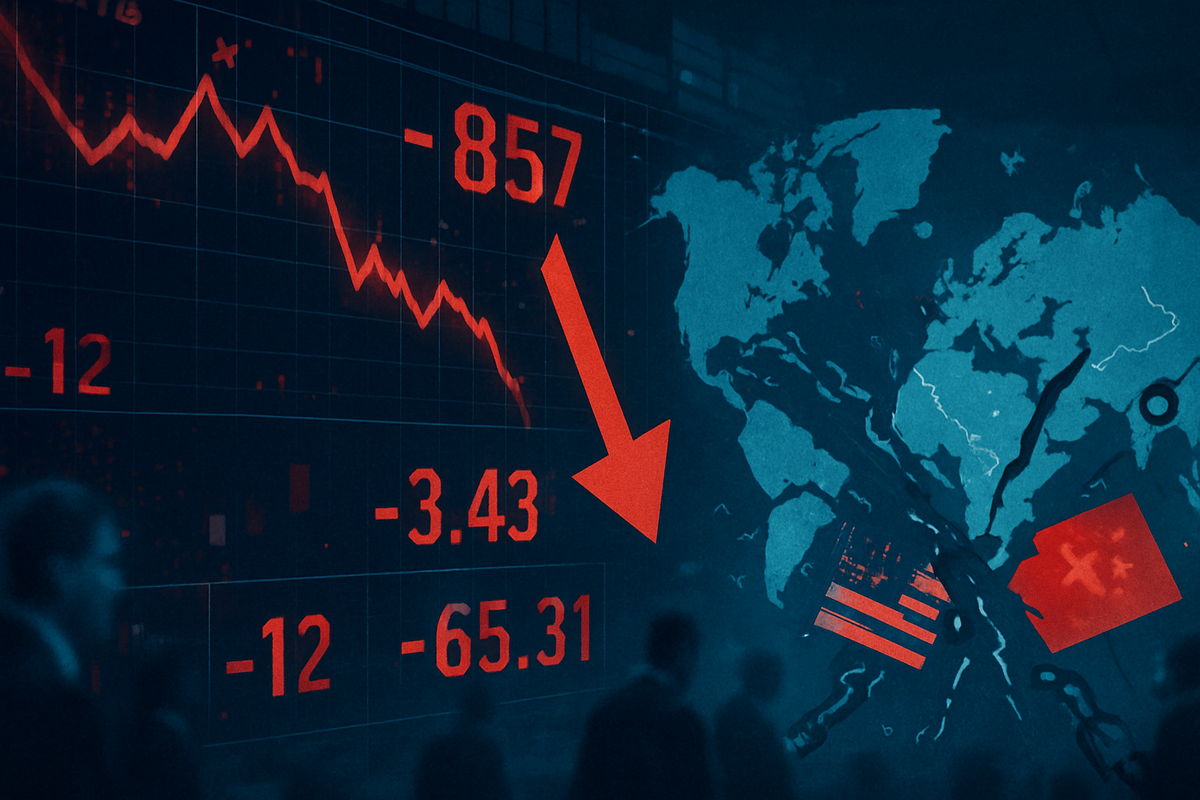
The global financial markets, which had soared to unprecedented valuations through late 2024 and early 2025, experienced a sharp and unsettling correction in April 2025. This significant downturn, triggered by the sudden implementation of aggressive tariff policies, marked a dramatic shift from widespread optimism to palpable fear, wiping out trillions in market value and raising serious concerns about global trade stability, inflation, and the specter of stagflation. As of October 2025, investors are grappling with the lasting implications of this seismic event, navigating a landscape reshaped by protectionist policies and persistent economic uncertainties.
The "Liberation Day" Shockwave: A Tariff-Induced Market Plunge
The market's precipitous fall began on April 2, 2025, a date some have dubbed "Liberation Day" due to the United States government's announcement of extensive new tariffs on nearly all imported goods. This unexpected policy shift, aimed at reshaping global trade dynamics, immediately ignited widespread panic selling across global stock markets. The S&P 500, Dow Jones Industrial Average, and Nasdaq Composite, which had been at record highs driven largely by the Artificial Intelligence (AI) revolution and robust corporate earnings, saw their valuations plummet.
Within just two days (April 3-4, 2025), the Dow Jones index shed over 4,000 points (9.48%), the S&P 500 dropped 10%, and the Nasdaq fell by 11%, collectively resulting in over $6.6 trillion in lost market value. The sell-off intensified on April 10, with the Dow losing another 1,344.50 points, or 3.22%, and the S&P 500 falling 3.15%. Investor sentiment rapidly devolved from euphoria to fear, reflected in the Chicago Board Options Exchange's VIX benchmark, often called "Wall Street's fear gauge," which spiked to 45.31 points—its highest close since the 2020 COVID-19 crash. Concerns about stretched valuations, particularly in the tech sector where some price-to-earnings (P/E) ratios, like Nvidia's (NASDAQ: NVDA), had reached 54, were already being voiced by institutions like the IMF prior to the tariffs. Key players like Nvidia (NASDAQ: NVDA), Microsoft (NASDAQ: MSFT), and Apple (NASDAQ: AAPL), whose mega-cap status had largely fueled the preceding bull run, found themselves at the epicenter of the correction. The initial market reaction was characterized by a rapid "flight to safety," as investors moved capital into perceived safer assets.
However, the market demonstrated a degree of resilience. By the second week of May 2025, a significant portion of the losses had been recovered, and by mid-2025, some indices, notably the S&P 500, had even returned to record territory. This quick rebound was attributed to solid U.S. economic growth and a subsequent easing of trade tensions, as the administration paused further tariff increases and initiated trade deals. Despite this swift recovery, the underlying concerns about the long-term economic damage from protectionist policies and the risk of stagflation—a combination of stagnant growth and high inflation—remained.
Corporate Fortunes: Who Wins and Who Loses in a Tariff Storm
The April 2025 tariff-induced correction created a bifurcated market, significantly impacting companies based on their exposure to global supply chains, domestic market focus, and pricing power.
Likely Losers emerged primarily from sectors heavily reliant on international trade and complex supply chains. Manufacturing and Industrials, especially those dependent on imported raw materials or exporting finished goods, faced increased input costs and retaliatory tariffs. Automotive manufacturers like Tesla (NASDAQ: TSLA), deeply integrated into global component networks, and electronics giants such as Apple (NASDAQ: AAPL) and Nvidia (NASDAQ: NVDA), with extensive supply chains in Asia, experienced higher production costs and potential disruptions. Companies in the Consumer Discretionary sector, including retailers (e.g., Nike (NYSE: NKE), Levi's (NYSE: LEVI), Gap (NYSE: GPS)) and hospitality, suffered from reduced consumer spending amid recessionary fears and higher prices for imported goods. Agriculture, a highly export-driven sector, was particularly vulnerable to retaliatory tariffs, leading to loss of key markets. Financial Services also faced headwinds from rising loan defaults and decreased asset values in an uncertain economic climate.
Conversely, Relative Winners (or those less negatively impacted) typically belonged to defensive sectors or had a strong domestic focus. Domestically oriented companies with strong pricing power, particularly those in less import-exposed sectors, could better absorb or pass on cost increases. Defensive sectors such as Healthcare, Utilities, and Consumer Staples proved more resilient. Pharmaceutical companies (e.g., Johnson & Johnson (NYSE: JNJ)), essential service providers, and producers of everyday necessities (e.g., Procter & Gamble (NYSE: PG), Clorox Co. (NYSE: CLX), Coca-Cola (NYSE: KO)) saw relatively stable demand. Companies with robust balance sheets and low leverage were better positioned to weather economic slowdowns and higher borrowing costs. While not immediate winners, companies that had proactively diversified their supply chains or engaged in reshoring/nearshoring efforts (e.g., "China+1" strategies) were better poised for long-term resilience against future tariff shocks.
Wider Significance: Deglobalization, Supply Chains, and Historical Echoes
The April 2025 tariff shock extends far beyond immediate market fluctuations, signaling a deeper reorientation of global economic architecture. It significantly accelerates the trend towards deglobalization, characterized by a partial reversal of global economic integration. This shift implies reduced sales growth and compressed profit margins for many S&P 500 firms, especially U.S. technology companies heavily reliant on foreign sales.
The tariffs also profoundly impacted supply chain resilience. Businesses are now compelled to aggressively diversify supplier networks, pursue nearshoring or reshoring initiatives, and invest heavily in scenario planning to navigate continuous tariff volatility. This strategic pivot aims to build agility and reduce reliance on single-country production hubs.
The ripple effects were widespread: domestic competitors in protected industries might see temporary advantages, but exporting firms face higher costs and reduced market access due to retaliatory tariffs. Partners—suppliers and distributors—grapple with increased operational costs and disruptions, leading to shifts in trade flows. Regulatory and policy implications are substantial, with tariffs escalating into trade wars that create complex compliance challenges and necessitate careful monitoring of rapidly changing trade rules. While temporary truces (like a 90-day pause on some retaliatory tariffs in May 2025) might de-escalate tensions, underlying structural issues often persist. Economically, tariffs contribute to inflation by raising import costs and reducing real incomes, potentially pushing economies toward recession.
Historically, the Smoot-Hawley Tariff Act of 1930 serves as a stark cautionary tale. This act, which drastically raised U.S. import duties, contributed to a cascade of retaliatory tariffs, a collapse in international trade, and the exacerbation of the Great Depression. More recently, the US-China Trade War of 2018-2019 demonstrated how tariffs could lead to significant economic uncertainty, increased costs for businesses, and a forced diversification of supply chains. The April 2025 event echoes these precedents, reminding policymakers and businesses of the severe and often unintended consequences of protectionist trade policies.
What Comes Next: Navigating a Volatile and Fragmented Future
Looking ahead from October 2025, the market and economy face a complex and uncertain trajectory following the tariff-induced correction.
Short-term (late 2025 - early 2026) possibilities include continued market volatility, moderated global growth (with some forecasts even suggesting a technical recession in the U.S. by 2026), persistent inflation, and ongoing supply chain disruptions. The threat of stagflation remains a significant concern. Long-term (2026 and beyond) possibilities point to elevated global volatility as a new normal, slower global growth, and a fundamental redrawing of global trade and supply chains. Persistent inflationary pressures and increased sovereign debt distress, particularly for emerging markets, are also likely. However, the powerful catalyst of Artificial Intelligence (AI) is still expected to drive long-term productivity gains and broader earnings growth beyond mega-cap tech, offering a potential counterbalance.
Strategic pivots are essential. Businesses must prioritize supply chain diversification and localization, focusing intensely on cost management and efficiency. Flexible and agile business models are crucial to adapt quickly to policy changes, alongside continued investment in technology like AI for enhanced productivity. Maintaining strong balance sheets will be paramount. For investors, diversification across asset classes (including commodities, real estate, and unlisted assets) is key. A focus on inflation hedges like gold and defensive, quality stocks (healthcare, utilities, consumer staples) will be prudent. Global diversification, maintaining cash reserves ("dry powder"), and adopting a patient, tactical investing approach are also vital.
Market opportunities may emerge in the AI and technology sector, commodities and real assets (as inflation hedges), and domestically focused companies less exposed to international trade. Select emerging markets demonstrating resilience could also present opportunities. However, challenges include persistent inflation and stagflation, ongoing geopolitical risks and trade wars, monetary policy uncertainty, and the pervasive risk of an economic slowdown or recession.
Potential scenarios range from a "muddle through," where the market stabilizes with temporary truces and gradual recovery, to a more severe stagflationary recession if aggressive tariffs persist. A rapid de-escalation and recovery is a more optimistic, though less likely, scenario. The April 2025 correction underscores that strategic agility and discerning investment choices are critical for navigating this new global economic order.
Wrap-Up: A New Era of Market Dynamics
The April 2025 market correction, born from aggressive tariff policies, stands as a pivotal event, fundamentally altering the market's trajectory and investor psychology.
Key takeaways include the profound impact of policy decisions on market stability, the immediate and far-reaching disruptions to global supply chains, and the persistent inflationary pressures that arise from protectionism. It highlighted the market's vulnerability to geopolitical risks and the acceleration of deglobalization trends.
Moving forward from October 2025, the market is expected to remain in an environment of heightened volatility. The lasting impact of trade tensions will continue to drive supply chain reconfigurations and potentially higher operating costs for businesses. Inflation, while perhaps not spiraling, is likely to settle at a higher plateau than pre-2022 levels, influencing central bank policies and borrowing costs. Geopolitical risks are now a baseline factor, significantly influencing commodity prices and investor sentiment.
Final thoughts emphasize that market volatility is no longer an anomaly but a defining characteristic of this new era, driven by "fat tails" where extreme market moves are more frequent. The correction served as a stark reminder that economic security is increasingly prioritized over efficiency.
Investors should watch for ongoing policy developments, particularly in trade negotiations and central bank monetary decisions. Close attention to key economic indicators—inflation rates, corporate earnings, GDP growth, and consumer spending—is crucial. Monitoring the geopolitical landscape for potential escalations and evaluating corporate resilience in adapting to new trade realities will be paramount. Embracing diversification, considering hedging strategies, and maintaining a long-term perspective with adequate liquidity will be essential for navigating the months ahead.
This content is intended for informational purposes only and is not financial advice








